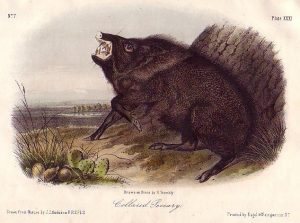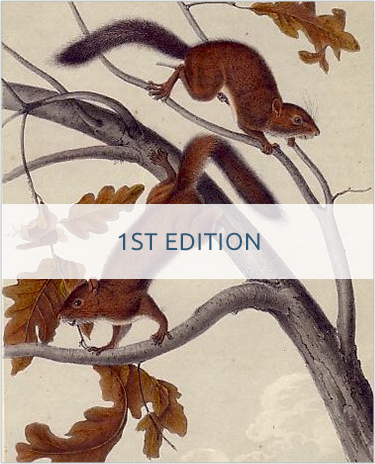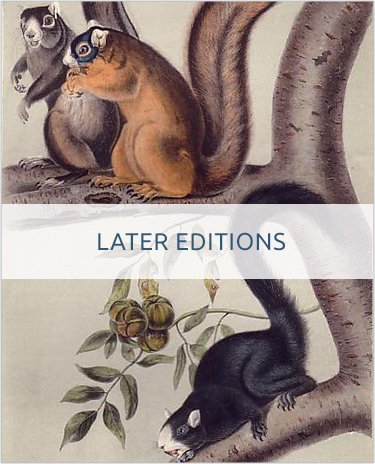 As Audubon did with his birds at the beginning of the decade, Audubon’s sons began to do in 1849 with his animals — issue the Quadrupeds by subscription in a smaller and more affordable version. The first edition of the octavo animals was issued in thirty-one numbers (also called parts or fascicles) from 1849 to 1854. Each number included five plates and accompanying text. The plates are stone lithographs after John James or John Woodhouse Audubon by one of two printers (either Philadelphia’s J. T. Bowen or the New York firm of Nagel & Weingaertner). The finished work (entitled The Quadrupeds of North America, the word Viviparous having been dropped from the title) was made up of three volumes, each about the size of a modern hardcover novel. Unlike the bird prints, virtually all plates in the octavo Quadruped series include a printed background (called a tint). Usually beige or aqua, the tint is either a simple rectangular background (in the case of vingnetted compositions) or includes an indication of clouds when the animal is shown in a landscape. Other than this printed background, all prints are entirely hand-colored with the plates measuring in the range of 10 to 11 inches by 6 to 7 inches.
As Audubon did with his birds at the beginning of the decade, Audubon’s sons began to do in 1849 with his animals — issue the Quadrupeds by subscription in a smaller and more affordable version. The first edition of the octavo animals was issued in thirty-one numbers (also called parts or fascicles) from 1849 to 1854. Each number included five plates and accompanying text. The plates are stone lithographs after John James or John Woodhouse Audubon by one of two printers (either Philadelphia’s J. T. Bowen or the New York firm of Nagel & Weingaertner). The finished work (entitled The Quadrupeds of North America, the word Viviparous having been dropped from the title) was made up of three volumes, each about the size of a modern hardcover novel. Unlike the bird prints, virtually all plates in the octavo Quadruped series include a printed background (called a tint). Usually beige or aqua, the tint is either a simple rectangular background (in the case of vingnetted compositions) or includes an indication of clouds when the animal is shown in a landscape. Other than this printed background, all prints are entirely hand-colored with the plates measuring in the range of 10 to 11 inches by 6 to 7 inches.
Unlike the octavo birds, there is little agreement concerning criteria for determining whether an octavo Quadruped print is a first or later edition based on examination. Although experienced collectors or dealers may have feelings about the approximate issue date for some prints (based on their perception of the relative quality of the printing and coloring or based on artist or printer credit lines), it is well established that prints from this series were not used in the same order they were made. Thus some prints appearing in later editions can be pretty certainly identified as having been printed early in the series history. For example the last Quadrupeds edition, three undated volumes circa 1871, was published by the George Lockwood Company using whatever inventory they had left including early prints. I have personally have had the experience of encountering what I believe to be later prints (based on lettering and credits) in volumes with dates that seem too early. This suggests the possibility that the Lockwood Company (which gained control of the stones and all other materials after the Audubon bankruptcy of the early 1860s) was not overly concerned about the accuracy of the dates in the volumes they published. Fortunately most of the title pages in the books seem to be accurate. Generally, I do not label a print as first edition unless I have first-hand knowledge that it comes from a first edition volume, or it comes from a highly trusted source.
I have remaining a nice selection of prints from a complete first octavo edition set of the Quadrupeds. The page offers very small photos (linked to larger images) of all the prints from the set for anyone interested in browsing the plates. I also have a selection of later edition prints plus a rare original number (five plates and text in wrappers) from the first edition.




